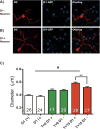Corticostriatal plasticity, neuronal ensembles, and regulation of drug-seeking behavior
- PMID: 29054293
- PMCID: PMC5794216
- DOI: 10.1016/bs.pbr.2017.07.013
Corticostriatal plasticity, neuronal ensembles, and regulation of drug-seeking behavior
Abstract
The idea that interconnected neuronal ensembles code for specific behaviors has been around for decades; however, recent technical improvements allow studying these networks and their causal role in initiating and maintaining behavior. In particular, the role of ensembles in drug-seeking behaviors in the context of addiction is being actively investigated. Concurrent with breakthroughs in quantifying ensembles, research has identified a role for synaptic glutamate spillover during relapse. In particular, the transient relapse-associated changes in glutamatergic synapses on accumbens neurons, as well as in adjacent astroglia and extracellular matrix, are key elements of the synaptic plasticity encoded by drug use and the metaplasticity induced by drug-associated cues that precipitate drug-seeking behaviors. Here, we briefly review the recent discoveries related to ensembles in the addiction field and then endeavor to link these discoveries with drug-induced striatal plasticity and cue-induced metaplasticity toward deeper neurobiological understandings of drug seeking.
Keywords: Cocaine self-administration; Cued reinstatement; Glutamate; Neuronal ensembles; Nucleus accumbens; Spines; Synaptic plasticity; Synaptic potentiation.
© 2017 Elsevier B.V. All rights reserved.
Figures




References
-
- Baker DA, Mcfarland K, Lake RW, Shen H, Tang XC, Toda S, Kalivas PW. Neuroadaptations in cystine-glutamate exchange underlie cocaine relapse. Nat Neurosci. 2003;6:743–9. - PubMed
-
- Balster RL, Schuster CR. A comparison of d-amphetamine, l-amphetamine, and methamphetamine self-administration in rhesus monkeys. Pharmacol Biochem Behav. 1973;1:67–71. - PubMed
Publication types
MeSH terms
Substances
Grants and funding
LinkOut - more resources
Full Text Sources
Other Literature Sources

